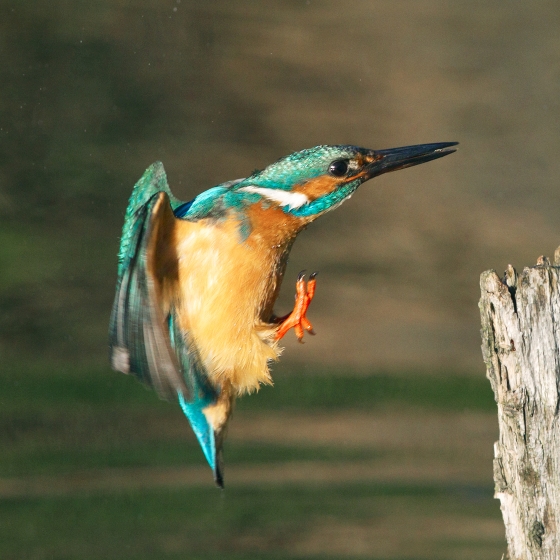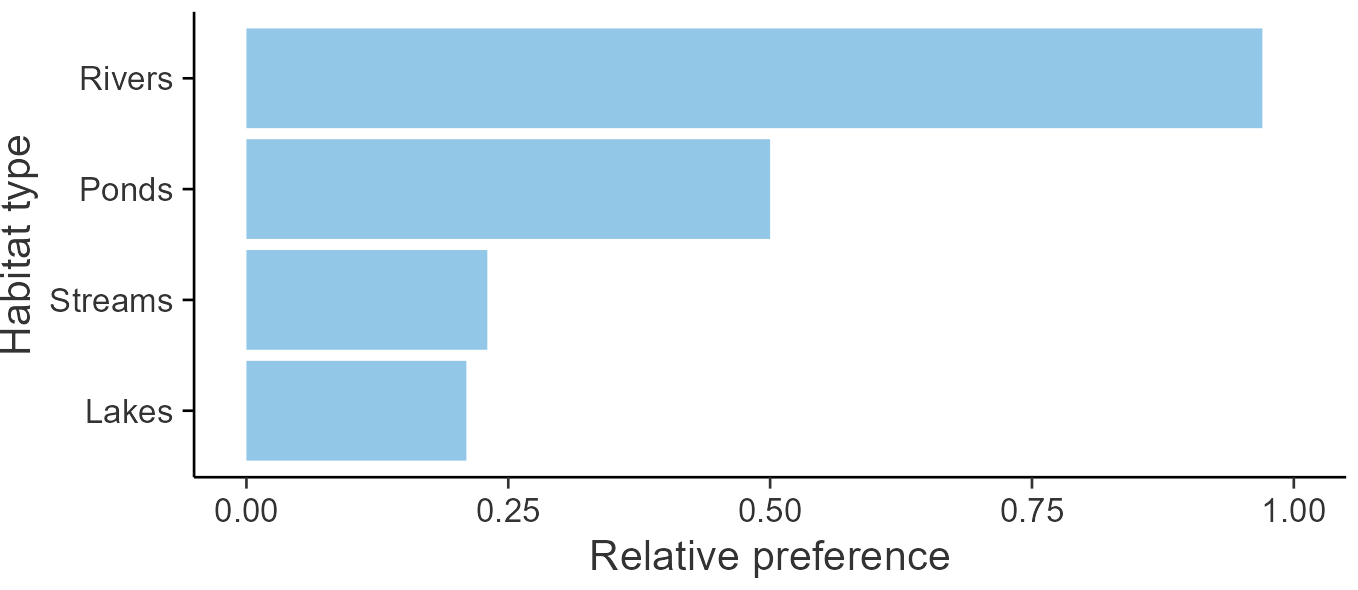Kingfisher

Introduction
Despite its brightly-coloured plumage, the Kingfisher can be a challenging bird to spot when perched on a waterside branch. More often than not you will be first alerted to its presence by its piping call.
Widely distributed on lowland rivers and still-waters, the Kingfisher is a species whose fortunes have waxed and waned. Numbers are impacted by severe winter weather, and this may be the main driver of change, but changing water quality and availability of favoured prey may also play a role.
Kingfishers may move away from their breeding territories during the winter months, including to more coastal sites, in order to reduce the impacts of poor winter weather on fishing opportunities.
- Our Trends Explorer gives you the latest insight into how this species' population is changing.

Key Stats
Identification
Songs and Calls
Song:
Call:
Flight call:
Begging call:
Status and Trends
Conservation Status
Population Change
The Kingfisher declined along linear waterways (its principal habitat) until the mid 1980s, since when it seems to have made a complete recovery, only to enter another decline, though numbers are still much higher now than in the mid 1980s. The initial decline was associated with a contraction of range in England (Gibbons et al. 1993). Though the amber listing of this species in the UK results from its 'depleted' status in Europe as a whole, numbers across Europe have fluctuated but have been broadly stable since 1991 (PECBMS: PECBMS 2020a>).
Distribution
Kingfishers are widely distributed on the lowland rivers of Britain & Ireland. They are resident, with some dispersal away from breeding territories outside the breeding period, especially by juvenile birds. In Britain this may explain the greater number of 10-km squares occupied in winter than in the breeding season.
Occupied 10-km squares in UK
2007/08–10/11
or view it on Bird Atlas Mapstore.
2008–11
or view it on Bird Atlas Mapstore.
European Distribution Map
Distribution Change
Patterns of distribution change indicate large gains in winter range in both Britain and Ireland since the 1981–84 Winter Atlas, when numbers were at a low point following several cold winters.
Change in occupied 10-km squares in the UK
from 1981–84 to 2007–11
or view it on Bird Atlas Mapstore.
from 1968–72 to 2008–11
or view it on Bird Atlas Mapstore.
Seasonality
Kingfishers are present throughout the year, though more likely to be recorded post-breeding in autumn.
Weekly pattern of occurrence
The graph shows when the species is present in the UK, with taller bars indicating a higher likelihood of encountering the species in appropriate regions and habitats.

Habitats
Breeding season habitats
Relative frequency by habitat
The graph shows the habitats occupied in the breeding season, with the most utilised habitats shown at the top. Bars of similar size indicate the species is equally likely to be recorded in those habitats.

Movement
Britain & Ireland movement
Foreign locations of birds ringed or recovered in Britain & Ireland
Dots show the foreign destinations of birds ringed in Britain & Ireland, and the origins of birds ringed overseas that were subsequently recaptured, resighted or found dead in Britain & Ireland. Dot colours indicate the time of year that the species was present at the location.
- Winter (Nov-Feb)
- Spring (Mar-Apr)
- Summer (May-Jul)
- Autumn (Aug-Oct)

European movements
EuroBirdPortal uses birdwatcher's records, such as those logged in BirdTrack to map the flows of birds as they arrive and depart Europe. See maps for this species here.
The Eurasian-African Migration Atlas shows movements of individual birds ringed or recovered in Europe. See maps for this species here.
Biology
Productivity and Nesting
Nesting timing
Egg measurements
Clutch Size
Incubation
Fledging
Survival and Longevity
Survival is shown as the proportion of birds surviving from one year to the next and is derived from bird ringing data. It can also be used to estimate how long birds typically live.
View number ringed each year in the Online Ringing Report.
Lifespan
Survival of adults
Survival of juveniles
Biometrics
Wing length and body weights are from live birds (source).
Wing length
Body weight
Ring Size
Classification, names and codes
Classification and Codes
- Order: Coraciiformes
- Family: Alcedinidae
- Scientific name: Alcedo atthis
- Authority: Linnaeus, 1758
- BTO 2-letter code: KF
- BTO 5-letter code: KINGF
- Euring code number: 8310
Alternate species names
- Catalan: blauet comú
- Czech: lednácek rícní
- Danish: Isfugl
- Dutch: IJsvogel
- Estonian: jäälind
- Finnish: kuningaskalastaja
- French: Martin-pêcheur d’Europe
- Gaelic: Biorra-crùidein
- German: Eisvogel
- Hungarian: jégmadár
- Icelandic: Bláþyrill
- Irish: Cruidín
- Italian: Martin pescatore
- Latvian: zivju dzenitis
- Lithuanian: paprastasis tulžys
- Norwegian: Isfugl
- Polish: zimorodek (zwyczajny)
- Portuguese: guarda-rios
- Slovak: rybárik riecny
- Slovenian: vodomec
- Spanish: Martín pescador común
- Swedish: kungsfiskare
- Welsh: Glas y Dorlan
- English folkname(s): Halcyon
Research
Causes of Change and Solutions
Causes of change
It is likely that winter weather is the main cause of population change for Kingfisher, although the possible effects of other potential longer term drivers of change (e.g. changes to water quality) have not been investigated.
Further information on causes of change
Kingfishers suffer severe mortality during harsh winters (for instance in the 1981/82 winter) but, with up to three broods in a season, and up to six chicks in a brood, their potential for rapid population growth is high. It is likely, therefore, that winter weather is the main driver of population change.
Information about conservation actions
Whilst severe weather is believed to be the main driver of annual population changes for this species, continued improvements to water quality and the provision of new wetland habitats are likely to have benefitted this species.
The provision of artificial nesting sites may enable this species to breed at sites where good quality natural nesting sites are limited or absent. This may include artificial sand or earth banks (Hopkins 2001) or alternative options such as artificial burrows drilled into a limestone cliff which were used by both Sand Martins and Kingfisher (Gulickx et al. 2007).
Publications (1)
Birds of Conservation Concern Wales 4: the population status of birds in Wales
Author: Johnstone, I.G., Hughes, J., Balmer, D.E., Brenchley, A., Facey, R.J., Lindley, P.J., Noble, D.G. & Taylor, R.C.
Published: 2022
The latest review of the conservation status of birds in Wales. The report assessed all 220 bird species which regularly occur in Wales. There are now 60 species of bird on the Red List, with 91 on ...
06.12.22
Reports Birds of Conservation Concern

More Evidence
More evidence from Conservation Evidence.com
Partners
Citing BirdFacts
If you wish to cite particular content in this page (e.g. a specific value) it is best to use the original sources as linked in the page. For a more general citation of the whole page please use: BTO (20XX) BirdFacts Species: profiles of birds occurring in the United Kingdom. BTO, Thetford (www.bto.org/birdfacts, accessed on xx/xx/xxxx).

